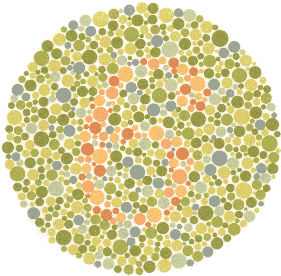This Sentence Is Blue



It is a common misconception that someone a color blind person can't see color. Color blindness has been incorrectly named from the day that it was coined. A better way to label it would be color deficient or color vision confusion. As you may have guessed, I am color deficient. When I tell people that, they can’t believe it since I am interface designer which demands the ability to properly use and distinguish between colors. People think that I see black and white.
Color deficiency basically means that I don’t see colors like others may. According to webmd.com, there are different varieties of color deficiencies, red-green (most common), followed by blue-yellow, and a severe and rare case named achromatopsia where you see in grayscale. I am red-green color deficient, which means that red and green might look similar. The next question that I usually hear when I tell people that is; how do I know to stop at a red light. Aside from red always being at the top or on the left, when I look at a red light, I see red and stop, when it’s green, I stop, and when the light is yellow, I speed up like everyone else. I just have trouble when red and green are close in the spectrum and when the ambient light is low. Since a traffic light projects light, there is no issue. I can tell that there are different shades of red and green, but some of the shades of the same color look identical to me. The shades need to be very close in color for me to get confused under normal lighting conditions. As far as I know, I never had an issue where something was green but it was actually red.

Being color deficient also means that I have trouble quickly passing an Ishihara color test. That is test where you can find out if you are color blind. It is not conclusive online since computer monitors display different variant’s of color, but it can be used to guide you if you should ask your optometrist to diagnose you. When I look at all the dots, it looks like a bunch of dots with no shapes present. Given time, I can map out a shape by slowly comparing one dot against another. It’s just not prevalent as you may see them. There is no cure or treatment for color deficiency and it means nothing, but it may help label you as an outcast color blind person and give you an excuse for going through that stop sign (Disclaimer: this will not work and the stop signs with white borders around them are not optional stops either). It can also help you understand why you have on one blue sock and one black one.
I have seen some minor conflicting numbers on several websites, but color deficiency is more common in males at 1 in 10 where females are .4% - 2% of the US population. So if you are a man and a girl ever tells you that sweater is green, you probably should trust her. Take the Ishihara test and comment back to let me know how you did.
No comments:
Post a Comment